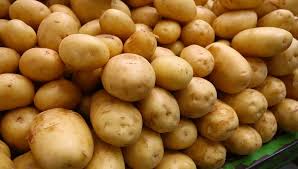
ScientificName:Solanum tuberosum
LifeTime: 1 to 2 weeks
Kingdom: Plantae
Clade: Tracheophytes
Clade: Angiosperms
Order: Solanales
Family: Solanaceae
The major species grown worldwide is Solanum tuberosum (a tetraploid with 48 chromosomes), and modern varieties of this species are the most widely cultivated. There are also four diploid species (with 24 chromosomes): S. stenotomum, S. phureja, S. goniocalyx, and S. ajanhuiri. There are two triploid species (with 36 chromosomes): S. chaucha and S. juzepczukii. There is one pentaploid cultivated species (with 60 chromosomes): S. curtilobum. There are two major subspecies of Solanum tuberosum: andigena, or Andean; and tuberosum, or Chilean.[23] The Andean potato is adapted to the short-day conditions prevalent in the mountainous equatorial and tropical regions where it originated; the Chilean potato, however, native to the Chiloé Archipelago, is adapted to the long-day conditions prevalent in the higher latitude region of southern Chile The International Potato Center, based in Lima, Peru, holds an ISO-accredited collection of potato germplasm.[25] The international Potato Genome Sequencing Consortium announced in 2009 that they had achieved a draft sequence of the potato genome.[26] The potato genome contains 12 chromosomes and 860 million base pairs, making it a medium-sized plant genome.[27] More than 99 percent of all current varieties of potatoes currently grown are direct descendants of a subspecies that once grew in the lowlands of south-central Chile.[28] Nonetheless, genetic testing of the wide variety of cultivars and wild species affirms that all potato subspecies derive from a single origin in the area of present-day southern Peru and extreme Northwestern Bolivia (from a species in the Solanum brevicaule complex).[5][6][7] The wild Crop Wild Relatives Prebreeding project encourages the use of wild relatives in breeding programs. Enriching and preserving the gene bank collection to make potatoes adaptive to diverse environmental conditions is seen as a pressing issue due to climate change.[29] Most modern potatoes grown in North America arrived through European settlement and not independently from the South American sources, although at least one wild potato species, Solanum fendleri, naturally ranges from Peru into Texas, where it is used in breeding for resistance to a nematode species that attacks cultivated potatoes. A secondary center of genetic variability of the potato is Mexico, where important wild species that have been used extensively in modern breeding are found, such as the hexaploid Solanum demissum, as a source of resistance to the devastating late blight disease.[30] Another relative native to this region, Solanum bulbocastanum, has been used to genetically engineer the potato to resist potato blight.[31] Potatoes yield abundantly with little effort, and adapt readily to diverse climates as long as the climate is cool and moist enough for the plants to gather sufficient water from the soil to form the starchy tubers. Potatoes do not keep very well in storage and are vulnerable to moulds that feed on the stored tubers and quickly turn them rotten, whereas crops such as grain can be stored for several years with a low risk of rot. The food energy yield of potatoes – about 9.2 million calories per acre (95 gigajoules per hectare) – is higher than that of maize (7.5 million), rice (7.4 million), wheat (3 million), or soybean (2.8 million).
The potato is a root vegetable native to the Americas, a starchy tuber of the plant Solanum tuberosum, and the plant itself, a perennial in the family Solanaceae.[2] Wild potato species, originating in modern day Peru, can be found throughout the Americas, from the United States to southern Chile.[3] The potato was originally believed to have been domesticated by indigenous peoples of the Americas independently in multiple locations,[4] but later genetic testing of the wide variety of cultivars and wild species traced a single origin for potatoes. In the area of present-day southern Peru and extreme northwestern Bolivia, from a species in the Solanum brevicaule complex, potatoes were domesticated approximately 7,000–10,000 years ago.[5][6][7] In the Andes region of South America, where the species is indigenous, some close relatives of the potato are cultivated.